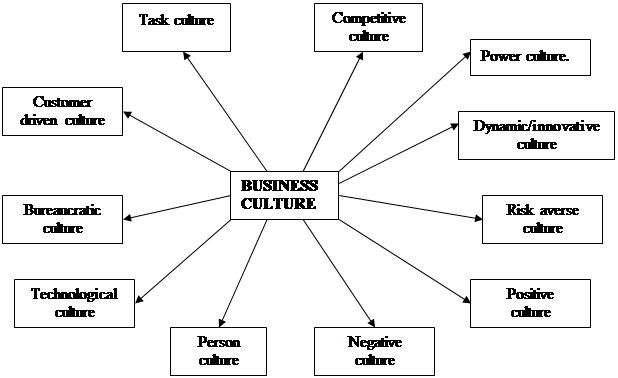The directors present their annual report to shareholders on the affairs of the Group together with the audited consolidated financial statements of the Group for the 52 weeks.
The principal activity of the Group is the operation of food stores and associated activities in the UK, Republic of Ireland, France, Czech Republic, Slovakia, Hungary, Poland and Thailand. A review of the business is contained in the Annual Review which is published separately and, together with this document, comprises the full Tesco PLC Annual report Accounts.
Culture
Culture in organisations is often described as the set of values, beliefs and attitudes of both employees and management that helps to influence decision-making and ultimately behaviour within them. Each organisation has a unique culture. This is what makes studying business behaviour so fascinating. The business culture helps to determine how things get done in firms and defines, quite simply, how the company works. The fact that organisations are themselves organic, composed of workers constantly interacting with each other and their environment, suggests that the culture in firms is not static and constant – the way firms operate can change, either intentionally through management action or more likely through natural evolution.
Corporate culture
Corporate culture is a set of values and beliefs that are shared by people and groups in an organisation. A simple way of explaining corporate culture might be to say that it is the ‘way that things are done in a business’. The corporate culture of a business can influence decision-making. It also encourages low level managers to behave like entrepreneurs. Business leaders are able to create a corporate culture to achieve a corporate objectives and strategy of the company. It is important that the corporate culture of a business is understood by all the people that work in the organisation. It is usually transmitted to new members and reinforced informally, by stores, symbols and socialisation, and more formally through training.
Advantages of a strong corporate culture.
· It provides a sense of identity for employees. They feel part of the business. This may allow workers to be flexible when the company needs to change or is having difficulties.
· Workers identify with other employees. This may help with aspects of the business such as team work.
· It increases the commitment of employees to the company. This may prevent problems such as high labour turnover or industrial relations problems .
· It motivates workers in their jobs. This may lead to increased productivity.
· It allows employees to understand what is going on around them. This can prevent misunderstanding in operations or instructions passed to them.
· It helps to reinforce the values of the organisation and senior management.
· It acts as a control device for management. This can help when setting company strategy.

Figure 1.8: Types of business culture.
Culture, presented within Tesco plc.
Tesco has achieved its position as Britain’s leading food retailer by offering excellent value and service to its customers. Underlying its business success is a commitment to upholding certain values, working principles and culture within the organisation, and to seek continuous improvement in its ethical performance. As a measure of its achievement to date, in 1997 the company came top in the Christian Aid league table for ethical commitment.
Customers.
Tesco must serve its customers by providing the goods they want and the service they expect. By meeting customer needs better than its competitors do, Tesco earns profits and creates value for its shareholders.
Customer service is at the heart of Tesco business culture. The base line is quality and value, but customers also look for a shopping environment which is attractive, well planned, and enjoyable. They also expect staff to be helpful, responsive to their needs, and sympathetic to their problems. Tesco is constantly seeking new ways of meeting customer needs. These include introducing Customer Assistants dedicated to helping customers at every point during their shopping, establishing a Customer Service Centre to deal with customer enquiries, providing facilities for customers with disabilities, and organising customer question times when Tesco can hear customers views.
Staff.
Tesco employs 154,000 people in the UK and 27,000 in Ireland and Europe. It is constantly told by customers that its staff are the company’s best asset. This means that the company must motivate and train its employees to give the best possible customer service, and provide opportunities for all members of staff to develop their talents to the full.
The company believes that the welfare and safety of its employees is of paramount importance, and applies high ethical standards to protect workers’ rights and reward employees fairly for their work. Full and part-time staff have had their benefits harmonised, including salaries, purchase discounts, pensions and profit-sharing. The company has a national agreement with USDAW, the shop workers’ trade union.
The approach of Tesco to worker welfare goes beyond its own employees. The company insists that its suppliers meet certain employment standards in matters such as fair pay or minimum working ages. Tesco believes it can play a positive role in influencing working practices around the world.
Like other large companies, however, Tesco recognises that its wider reputation depends on other things, such as its staff relations, its attitude to the environment, its support to the community, and its relationships with its suppliers. Also, as a leading food retailer, the company must ensure that it provides products, which are safe to eat or use, as well as giving customers advice on matters such as healthy diets.
Health and safety
Tesco customers rightly expect that their purchases will be safe to eat or use. The company applies the highest standards in meeting these expectations and makes special provision for those with special dietary needs. Following government recommendations on the nation’s diet, Tesco was the first retailer to promote healthy eating.
Environmental policies
Tesco is committed to protecting the environment and to using its commercial strength to put its principles into practice. In many cases, the company’s standards far exceed legal requirements. Its environmental policies cover matters such as recycling of packaging, working with suppliers to minimise the use of pesticides, energy conservation, and the siting and design of its stores. Tesco also works closely with environmental organisations in areas relevant to its business.
Animal welfare
The company aims to set the highest standards of animal welfare in the industry, and has introduced a code of practice on the treatment of animals to which all its suppliers must adhere. The company is also funding research to improve understanding of animal welfare, and will continue to promote and implement high standards in order to improve animal husbandry still further.
Tesco has relationships with thousands of suppliers in the UK and overseas, and works closely with these suppliers in order to ensure that products are of the highest quality and delivered in the best possible condition. By working in close partnership with its suppliers, Tesco is helping them to meet its own high standards, not just in efficiency and product quality, but also in environmental protection, animal welfare and employment practices.
The community
Tesco is very much part of local communities throughout the UK and is committed to playing a positive role by working with community organisations. The company’s community contribution covers support for education, groups dedicated to helping people with disabilities, and a wide variety of other organisations. The company has introduced schemes which enable its own staff and customers to help raise money for good causes.
Each large supermarket retailer in Britain has its own corporate identity and culture. Often these are very similar, yet each organisation seeks to present its own individual image. Of the types of cultures that I have discussed above, I think that Tesco displays many of these differing forms, especially customer driven or customer orientated, task culture, competitive culture, innovative culture and positive culture. It is often said that in business “the customer is King” and this is very true of Tesco, which operates in a very competitive market. It must be very heavily customer orientated as satisfied customers will usually regularly return, but dissatisfied customers may not …. and go elsewhere! It is also very innovative, always encouraging new ideas and products, e.g. the possible introduction of car sales. Tesco used to be a food retailer, but now it also sells clothing, electrical goods, books and stationary, computers, mobile phones, etc. It has a very positive culture as it is always searching for new opportunities for its staff and also its retail products. Its success is now a good indicator of how this blend of business cultures has led to market growth and market leadership.
E5
Communications
The efficient communication of information is particularly important for organisation that operates in competitive markets. Relevant and accurate information is needed to plan and manage efficient production, marketing, distribution and cost control. Information – whatever it is nature and purpose – must be communicated as efficiently as possible.
All people in an organisation are part of an information flow – they are involved to varying degrees in providing and receiving information. However, there are three main levels at which information is required:
· operational level
· middle management
· senior management.
Operational level
At the operational level – on the factory floor, in the office or at premises where consumer services are provided – there are charge hands and supervisors who must ensure that work is planned and carried out as efficiently as possible. In a factory, for example, a supervisor giving the task of overseeing the production of a particular item needs to know:
- the quantity to be handle
- the completion date
- the availability of plans and machine capacity
- the operations to be performed
- the kinds of labour needed and its availability
- the materials and components required to produce the order.
The kind of information assists the supervisor in planning and controlling he work and it is essential for decision making at an operational level. Activities at the operational of an organisation produce data that will be processed to provide much of the information required by middle management.
Middle management
Middle management needs to know how efficiently work at operational level is been carried out and the extend to which any resources under their control are being used to achieve the organisation’s objectives. Much of this information relates to the productivity of labour, the utilisation of machine capacity and the rate at which materials and other inputs are being consumed.
Middle management also needs a great deal of financial information about the costs of the resources consumed in relation to output. This financial data can be used to determine and monitor total costs, revenues, profits and the achievement of business objectives for example, it will be possible to identify any fall-off in productivity or rise in labour costs which might contribute to arise in unit labour costs or to detect the excessive use of materials which might suggest an increased in wastage.
Senior management
So far, I have mainly considered the need for information that is processed and generated from sources within the organisation. At senior level, however, information from internal sources often has to be supported by information derive from external sources to help managers ensure that the resources and their control are used as efficiently as possible in achieving business objectives. Decision making at senior management level has a major influence on the success or failure of the organisation. Any decisions concerned with controlling the organisation, assessing its performance, planning its future and initiating action must be supported by all relevant information.
Decision making at senior level in areas such as business strategy and planning requires information about broad trends rather than detailed information needed to make many routine decisions on day-to-day matters at lower levels of the organisation. Senior management need information about:
- developments in initial costs and sale trends
- overall profitability, and the respective contribution of each part of the business
- capital requirements, and availability of internal funds and the cost and sources of external capital
- manpower and skills requirements
- forecast of demand of the organisation’s markets
- the impact on business of any changes in the economic, political, social and legal environment.


![]() Superior
Superior


![]()
![]()
![]() Prep Line manager Prep
Prep Line manager Prep
group group
 |
 |
Staff Subordinates Staff
![]() relationships relationships
relationships relationships
Figure 1.9: Communication network
Communication channels and methods
The communication channel refers to the means by which information is communicated. The actual choice of communication channel depends upon a combination of:
- the need for an immediate feedback or response
- costs
- speed and urgency
- the number and location of the people who need the information
- the degree of confidentiality and security required
- the desired degree of formality
- convenience
- the complexity and amount of detail to be conveyed
- the type of information to be communicated
- the need to keep a record of the communication.
Business information can be communicated in many ways. Methods include:
- written reports
- instruction manuals
- letters, circulars and memoranda
- material posted on notice board
- in-house magazines and newspapers
- sheets of figures
- information on standard forms
- graphs, charts, drawings and photographed
- video, television and other audio-visual techniques
- meetings and interviews
- public address announcements
- electronic mail
- network messaging
- fax
- telephone and voice mail
- pager device
- video conferencing
Whatever communication method is used, the information sent should be relevant and avoid superfluous comments and unnecessary detail. The information communicated to a supervisor on a factory may have to include an exact description of the operations to be carried out. In contrast, much broader information is supplied to middle and senior management. Senior managers may only require general indicators and a broad description of the developments that need to be considered when assessing the organisation’s performance, setting objectives and deciding upon strategies.
Exception reporting
To ensure tht the information provided to management is relevant, clear and concise and makes effective use of managers’ time, some organisations stipulate that managers are only provided with dada relating to exceptional developments. Middle management, for example, may only receive information connected with performance measurements that deviate by more than an agreed percentage from their targets. The information dealing with exceptional performance should also be supported by brief statements of the internal and/or external factors that may have contributed to any exceptional performance. Exception reporting makes more effective use of the time and skills that middle management devotes to decision making and to initiating and controlling actions.
Downward information flows
A downward information flow describes the provision of information by a superior to an immediate subordinate. It is, therefore, concerned with internal communications as part of a formal
29-04-2015, 04:40
